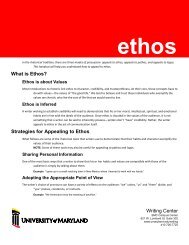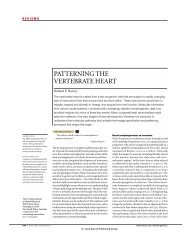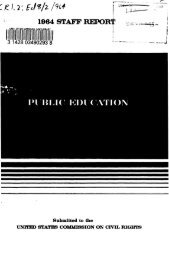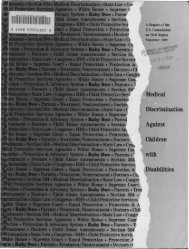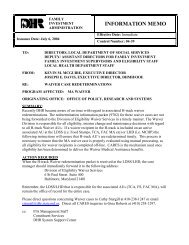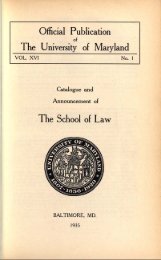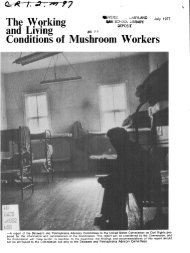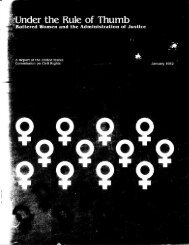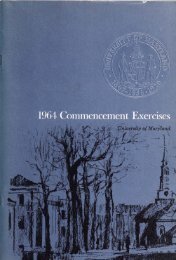1961 US Commission on Civil Rights Report Book 2 - University of ...
1961 US Commission on Civil Rights Report Book 2 - University of ...
1961 US Commission on Civil Rights Report Book 2 - University of ...
Create successful ePaper yourself
Turn your PDF publications into a flip-book with our unique Google optimized e-Paper software.
choice is between two schools having a prep<strong>on</strong>derantly, and <strong>on</strong>e having<br />
a slightly less than 15 percent, 49 Negro enrollment. Under this plan<br />
school authorities are relatively immune from charges <strong>of</strong> segregati<strong>on</strong> by<br />
z<strong>on</strong>ing.<br />
SITE SELECTION<br />
School boards usually are authorized to select sites for new schools.<br />
This, like the power to fix attendance z<strong>on</strong>es, if misused to promote racial<br />
segregati<strong>on</strong>, would seem to c<strong>on</strong>stitute State acti<strong>on</strong> that is forbidden by<br />
the equal protecti<strong>on</strong> clause. Apparently the New Rochelle case (discussed<br />
above with regard to the gerrymander) is the <strong>on</strong>ly <strong>on</strong>e in which<br />
a charge <strong>of</strong> abuse <strong>of</strong> authority was sustained <strong>on</strong> this ground.<br />
In Sealy v. Department <strong>of</strong> Public Instructi<strong>on</strong> <strong>of</strong> Pennsylvania 80 in<br />
1957 an effort to prove discriminati<strong>on</strong> by site selecti<strong>on</strong> failed. The<br />
facts showed that the school district in questi<strong>on</strong> was composed <strong>of</strong> two<br />
n<strong>on</strong>c<strong>on</strong>tiguous areas. The upper secti<strong>on</strong> had a Negro public school<br />
populati<strong>on</strong> <strong>of</strong> less than 5 percent, the lower <strong>of</strong> more than 95 percent.<br />
Even after allowing for the large number <strong>of</strong> children (particularly<br />
whites living in the upper secti<strong>on</strong>) who attended a Catholic parochial<br />
school, there were about 17 percent more public school students living<br />
in the upper, than in the lower secti<strong>on</strong>. A new school was to be built<br />
to replace an old <strong>on</strong>e located in the lower secti<strong>on</strong>. It was to serve all<br />
children living in the district. The trial court found no evidence that the<br />
school board had been motivated by any racial c<strong>on</strong>siderati<strong>on</strong> in its decisi<strong>on</strong><br />
to locate the school in the upper secti<strong>on</strong>. Since all junior high<br />
students in the district, both Negro and white, would be free to attend the<br />
new school, no real questi<strong>on</strong> <strong>of</strong> creating a segregated school by site<br />
selecti<strong>on</strong> was involved in the case.<br />
In affirming the lower court decisi<strong>on</strong>, the United States Court <strong>of</strong><br />
Appeals for the Third Circuit said: 81<br />
The locati<strong>on</strong> <strong>of</strong> schools assuredly is <strong>on</strong>e for State school authorities<br />
and local school boards; for State, not nati<strong>on</strong>al courts, unless there<br />
be a deprivati<strong>on</strong> <strong>of</strong> rights guaranteed by the i4th amendment.<br />
The plaintiffs have failed to prove their case.<br />
In the P<strong>on</strong>tiac case, referred to above, discriminati<strong>on</strong> by site selecti<strong>on</strong><br />
was also charged. The facts showed that two sites had been c<strong>on</strong>sidered.<br />
One was located in a densely populated Negro neighborhood, the other<br />
in a rather remote, but apparently less racially c<strong>on</strong>gested area. The<br />
107



